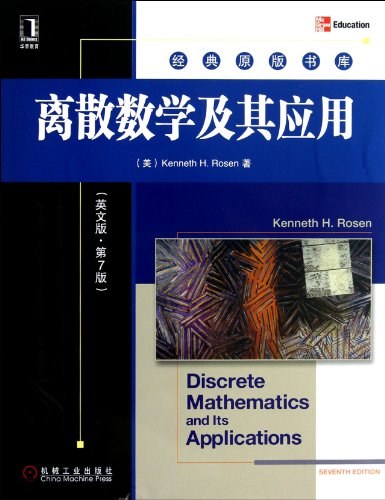
书名:离散数学及其应用
作者:KennethH.Rosen
译者:
ISBN:9787111385509
出版社:机械工业出版社
出版时间:2012-11
格式:epub/mobi/azw3/pdf
页数:944
豆瓣评分: 9.1
书籍简介:
本书是介绍离散数学理论和方法的经典教材,已经成为采用率最高的离散数学教材,被美国众多名校用作教材,获得了极大的成功。中文版也已被国内大学广泛采用为教材。作者参考使用教师和学生的反馈,并结合自身对教育的洞察,对第7版做了大量的改进,使其成为更有效的教学工具。. 本书可作为1至2个学期的离散数学课入门教材,适用于数学,计算机科学。计算机工程.信息技术等专业的学生。 本书特点 实例:书中有800多个实例,用于阐明概念,联系不同内容,引入各种应用。 应用:书中叙述的应用展示了离散数学在解决现实问题中的使用价值,涉及的应用领域包括计算机科学、数据网络、心理学、化学、工程、语言学、生物学、商业和互联网等。 算法:离散数学的结论常常要用算法来表示,因此本书每一章都介绍了一些关键算法。 历史资料:本书对许多主题的背景作了简要介绍,并以脚注的形式给出了83位对离散数学做出过重要贡献的数学家和计算机科学家的简短传记。 关键术语和结论:每一章后面都列出了本章的关键术语和结论。 练习题、复习题和补充练习:书中有4000多道难度各异的练习题,可以满足不同层次学生的学习需求。同时,每章最后都有一组复习题和丰富多样的补充练习。 计算机课题:每一章后面还有一组计算机课题,大约有150个这样的题目,把学生已经学到的计算和离散数学的内容结合在一起。 计算和研究:每一章的结论部分都有一组计算和研究性问题,为学生提供了通过计算发现新事实或新思想的机会。 写作题目:每一章后面都有一组应该书面完成的题目。要完成这类题目,学生需要查阅参考文献,把数学概念和书面写作的过程结合在一起,以帮助学生研究和思考正文中没有深入探讨的思想,便于其未来的学习和研究。
作者简介:
Rosen 博士于1972年获密歇根大学数学学士学位,1976年获麻省理工学院数学博士学位,其博士论文研究的是数论,导师是Harold Stark 。曾就职于科罗拉多大学、俄亥俄州立大学、缅因大学,后加盟贝尔实验室,现为AT&T实验室特别成员。他目前还是蒙茅斯大学客座研究教授,主要从事快速反应数据库项目的安全和保密方面的工作,同时教授密码应用课程。此外,他还是CRC出版社离散数学丛书的编辑顾问。
Rosen博士在专业期刊上发表过许多关于数论及数学建模的文章。《初等数论及其应用》和《离散数学及其应用》这两本书均被国际上几百所大学广为采用。
书友短评:
@ タワぽん 2个多月,大概通读了一遍。30几页的A4纸,双面记满了所有定理、公式及其他重要结论。习题只挑着做偏简单和适中的题目,及补充有新概念的题目(这本书的习题量太惊人了)。不得不说读起来太舒服了,作者把复杂的问题写得简单易懂,就看个人有没有耐力读下去了。即使是复杂的证明也能看懂个大概,但我看到第十章后就有点浮躁了,只记下重要结论。细品的话,应该也能都看懂吧?我将其定位为启蒙书,因为这本书能激发继续学习深度知识的兴趣。比如去补充学习数学的线性代数,概率统计,数论,组合数学等,或去看看计算机相关的底层书籍,数据结构,网络等。内容包罗万象又引出应用,可读性高。总之本科阶段能遇上这本书,感到太幸运了。 @ 喋喋不休 机械工业出版社的这本纸真的薄得仿佛重影,字也小的可怜 @ TBC. 花了几个月总算啃完了,做了简略的笔记,以后可以根据笔记按图索骥 @ Victor 用了三周浏览了一遍 @ Liuvier 上学期没把离散当回事,想着正文内容都看一遍就完事了然后血淋淋的79就出来了现在完整地做了chapter6,7,8的所有习题感觉上个学期没做课后习题真是巨大的损失忠告:一定要做习题呀下学期离散考了93,也算圆满 @ Ethanity 粗粗翻了一遍 非常好的书 可惜没有早点读到 @ Joule 看的英文版,思路很清楚,但是废话太多了。另外奉劝浙大学子千万不要上吴江琴的离散课,预制上也退了!
《离散数学及其应用(英文版第7版)》
preface iv
about theauthor xiii
the companion website xiv
to the studentxvi
list of symbols xix
1 the foundations:logic and proofs
1.1 propositional logic
1.2 applications of propositional logic
1.3 propositional equivalences
1.4 predicates andquantifiers
1.5 nested quantifiers
1.6 rules of inference
1.7 introduction to proofs
1.8 proofmethods and strategy
end-of-chaptermaterial-
2 basic structures:sets,functions,sequences,sums,and matrices
2.1 sets
2.2 set operations
2.3 functions
.2.4 sequences and summations
2.5 cardinality of sets
2.6 matrices
end-of-chaptermaterial
3 algorithms
3.1 algorithms
3.2 the growth of functions
3.3 complexity of algofithms
end-of-chapter material
4 number theory and cryptography
4.1 divisibilitv andmodular arithmetic
4.2 integer representations andalgorithms
4.3 primesand greatest common divisors
4.4 solving congruences
4.5 applications of congruences
4.6 cryptography
end-of-chapter material
5 induction and recursion
5.1 mathematical induction
5.2 strong induction and well-ordering
5.3 recursive definitions and structural induction
5.4 recursive algorithms
5.5 program correctness
end-of-chapter material
6 counting
6.1 tlle basics of counting
6.2 the pigeonhole principle
6.3 permutations and combinations
6.4 binomial coefficients and identities
6.5 generalized permutations and combinations
6.6 generating permutations and combinations
end-of-chapter material
7 discrete probability
7.1 an introduction to discrete probability
7.2 probability theory
7.3 bayes’theorem
7.4 expected value and variance
end-of-chapter material
8 advanced counring technigues
8.1 applications of recurrence relations
8.2 solving linear recurrence relations
8.3 divide-and-conquer algorithms and recurrence relations
8.4 generating functions
8.5 inclusion-exclusion
8.6 applications of inclusion-exclusion
end—of-chapter material
9 relations
9.1 relations and their properties
9.2 n-ary relations and theirapplications
9.3 representing relations
9.4 closures of relations
9.5 equivalence relations
9.6 partial orderings
end-of-chapter material
10 graphs
10.1 graphs andgraphmodels
10.2 graph terminology and special types of graphs
10.3 representing graphs and graph isomorphism
10.4 connectivity
10.5 eulerandhamiltonpaths
10.6 shortest.pathproblems
10.7 planargraphs
10.8 graphcoloring
end-of-chapter material
11 trees
11.1 introduction to trees
11.2 applications of trees
11.3 tree travcrsal
11.4 spanning trees
11.5 minimum spanning trees
end-of-chapter material
12 boolean algebra
12.1 boolean functions
12.2 representing boolean functions
12.3 logic gates
12.4 minimization of circuits
end-of-chapter material
13 modeling cornputation
13.1 languagesand grammars
13.2 finite-state machines with output
13.3 finite-state machines with no output
13.4 languagerecognition
13.5 turing machines
end-of-chapter material
appendixes
1 axioms for the real numbers and the positive integers
2 exponential and logarithmic functions
3 pseudocode
suggestedreadings b-1
answers to odd-numbered exercises s-1
photo credits c-1
index ofbiographies i-1
index i-2
· · · · · ·
经典原版书库(共379册),这套丛书还有《深度强化学习》《算法分析导论》《高速网络与因特网性能与服务质量(英文版 第2版)》《科学计算导论》《并行计算导论》等。
添加微信公众号:好书天下获取
 好书天下
好书天下
评论前必须登录!
注册